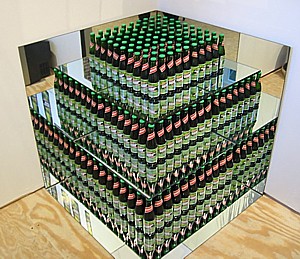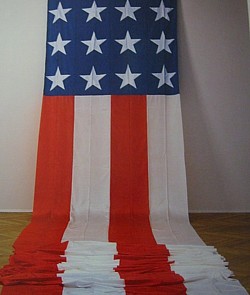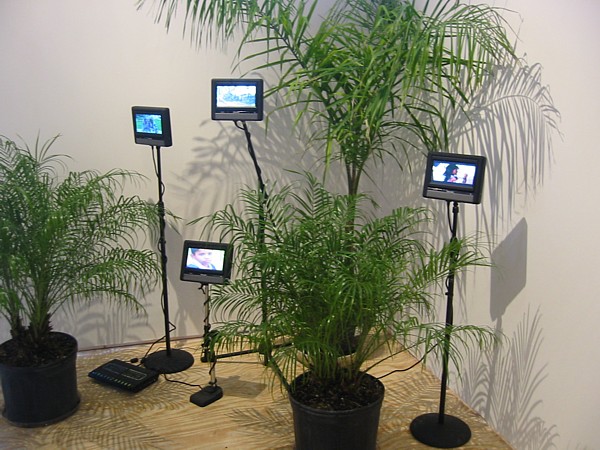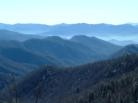
Superflex: Guarana Power (display of Guarana soda)
Riffs on a Global Groove
I was in Tennessee just recently to give a little talk at the brand new Art Gallery of Knoxville, where until the end of the month there’s an exhibition called “Global Groove (Nation Building As Art).” It was curated by director Chris Molinsky. Molinsky, Leslie Starritt, and Bryan McCullough (all recent graduates of the Art Institute of Chicago) are cofounders of this bright new space, which opened in November. My theme, in honor of “Global Groove,” was art globalization.
Internationalism is not new. There was Zurich Dada, Berlin Dada, Paris Dada, and New York Dada. According to situationist Vaoul Vaneigem (in his vituperative, mostly anti-Surrealist textbook called A Cavalier History of Surrealism, AK Press). there were surrealist groups in Romania, Yugoslavia, Czechoslovakia, Scandinavia, Belgium, Italy, South America, the Canary Islands, Mexico, Japan, Haiti and, of course, Paris, where it all started.
The New York School – i.e., Abstract Expressionism – included the Russian-born Mark Rothko, Hans Hofmann from Germany, Arshile Gorky from Armenia, Willem de Kooning from the Netherlands, and Matta from Chile.
But globalism is something more than internationalism or even cosmopolitanism. Even yours truly has traveled far and wide in the service of art: Australia, Brazil, Finland, Germany, Iceland, Israel, Italy, Japan, New Zealand, Norway, Ponape in Micronesia, Sweden, Tahiti. And as an artist I have recently exhibited work in Berlin, the United Arab Emirates and Beijing.
Artopia, of course, covers the world. And thus we get closer to globalism as a culture superimposed upon and perhaps superceding all national subcultures thanks to the internet, our new hope.
The title “Global Groove” comes from video pioneer Nam-Jun Paik, whose thoughts from way back at the beginning of McLuhan’s Global Village – to which he opposes the Global Groove —can be found on theArt Gallery of Knoxvillewebsite. You have to search for it a bit, but clicking on a rainbow of little buttons will yield Paik’s essay and many other goodies, such as all you need to know about the kingdom of Elgaland -Vargaland, Superflex’s Guarana project, etc. There is alsoa video podcast of my well-attended talk.
In the meantime, suffice it to say that in my talk I could not help but entertain the dark side of globalization, investigating if there is a connection between art globalization and corporate/pop culture globalization. There is, let it be said, the ever-present danger of global uniformity. After a while, one installation looks like any other; one motion picture projected on a gallery or museum wall is just a representation of other projected motion pictures. If art globalization must be separated from corporate globalization, perhaps this can be achieved by using art as immunization against globalization, or as an infection that is spread by economic globalization.
The way I see it, there are two parts to “Global Groove”: representations of various global or borderland projects in the gallery itself, and a website manifestation that demonstrates global themes.

The official flag of Elgaland-Vargaland
How Global Is It?
As a critic, artist, and poet I have long been interested in borders, borderlands, or what could also be called thresholds: not only between nations, but between genres (poetry/prose, painting/sculpture, philosophy/dance) and between disciplines (poetry/criticism, art/philosophy).
As the ongoing Artopia text is to normal blogs, my more complicated investigations are to Artopia. I have been reading an extremely academic book called Ghazali and the Poetics of Imagination (University of North Carolina Press) in which author Ebrahim Moosa, who was born in South Africa but was impressed by a major text by al-Ghazali in his youth in Bombay, emphasizes the importance of the threshold (dihlîz) in Gahzali’s thinking. This is perhaps best emblemized by the threshold between the oral and the written, between jurisprudence (of all things) and mysticism. Al-Ghazali (1059-1111) is by all accounts one of the great world-thinkers – he is sometimes considered the Thomas Aquinas of Islam, but in his later, post-Aristotle phase he became a Sufi giant.
The Art Gallery of Knoxville is itself a threshold, in that it occupies a borderland between physical gallery and website in much the same way that Philadelphia’s Slought Foundation does. Slought, which we may visit at some other time, has been in existence since 2002 and consequently has a big archive of lectures and panel discussions on its website: Slought. But hold onto your hats; here comes Knoxville. Links become both the catalog of the physical exhibition and an online exhibition in itself.
Tennessee itself is a borderland occupying a new territory between the Southern and the postmodern. Knoxville is associated with the Tennessee Valley Authority. That huge project involving the damming of the Tennessee River and the sometimes needless destruction of farms, created cheap hydroelectric power. If that were not enough of modern culture, there is the “secret city” of the Oak Ridge Laboratories that had so much to do with the creation of the atomic bomb and atomic energy. Tourists can now take train rides through the Oak Ridge “secret city,” but touristically it does not rival the nearby Dollywood (Dolly Parton’s theme park. Oak Ridge may have slightly more significance. Maybe not.
Knoxville sports a huge university – sometimes referred to as The Fort (which tells it all) – and a downtown in the throes of revival. The handsome, compact Edward Larabee Barnes-designed Knoxville Art Museum, overlooks the site of the 1984 World’s Fair – which is the border between the University and Downtown.
The Art Gallery of Knoxville is located in downtown Knoxville at the north end of Gay Street, the present art gallery row. Unfortunately, the month the Gallery opened, the city tore down the bridge connecting South and North Gay Street and spanning the freight-train tracks. Not to fear; the Gay Street Viaduct will be rebuilt. In the meantime, The Gallery, proudly proclaims cofounder Starritt, is in No Man’s Land. It is even a number of block from the Old Town saloon scene, where many a country-music star had been known to drink to excess. There is a boulder by the Tennessee River, someone tells me after my lecture, with the ancient inscription: “now I know why the devil made Knoxville.”
The Gallery is modest but elegant. One side of a double storefront houses the exhibition module, which is basically a freestanding, 15-foot plywood cube with the top and front removed. You can walk around the outside and see the beams and nails, but the inside is gallery-finished. If anyone wanted to book a show out of the Art Gallery of Knoxville, the exhibition space could be easily and precisely duplicated. The other half of the double storefront is used for Wednesday night public events and has a table with books for sale, paintings up on the wall, and a TV monitor.
There’s a lot of video in Molinsky’s complex, clever “Global Grove”; little screens on microphone stands in a forest of potted plants show, for instance, Valery Grancher’s “The Shiwiars Project” documenting a remote Amazon village. A nearby wall-mounted monitor screens Phill Niblock’s The Movement of People Working – no plot, no comment, but long takes of people making things in Mexico and Peru, with the composer’s drone music as background. Also shown: Gordon Matta-Clark’s (1974) video documentation of “gutterspace” in Queens, useless slivers of land put up for sale by the City of New York.
Having been to Brazil (only Rio and Sao Paulo), I was much taken with Superflex’s Guarana Power: worker-harvested guarana, used in soda, bottled in Denmark. Guarana essence is the operative speed in the Brazilian national soda-pop . The “myth” I heard in Rio was that Coca-Cola was buying up the guarana plants to prevent it becoming a rival, since, as Cariocas can testify, guarana pop has a bigger buzz. And, from Sweden, CM von Hausswolff and Leif Elggren’s Elgaland-Vargaland (represented by the Elgaland-Vargaland flag and a case full of stamps and other “ephemera”) is droll indeed. Elgaland-Vargaland is made up of all the existing borders between countries; you can apply for citizenship online.
Here we must note that there is a long history of imaginary countries. The French critic Pierre Restany had his own nation, complete with postage stamps. Artopia, of course, is transnational, but not a country per se. It is instead a state of mind, an imaginal domain that supersedes lesser realities. No postage stamps or flags are necessary.
On The Art Gallery of Knoxville website you can find an essay from a recent issue of Cabinet magazine dedicated to “fictional” countries. This leads me to the website part of the exhibition. Beware. It fans out into enormous alleyways and pathways. The Superflex site is particularly seductive: there’s more than soda and a lot of Fluxus and links to fascinating videos.
Are we therefore closer to website exhibitions without any physical manifestations? Not yet, but perhaps soon.

“Global Groove” video display (partial).
* * *

Thresholds of Past and Present
I gained a lot by traveling to Knoxville. Not only was I reminded about how annoying air travel can be, but I also got another glimpse of the Smoky Mountains. Ten years ago, involved in a project for the North Carolina State Arts Council, I visited the Smoky Mountains to visit the charming John C. Campbell Folk School near Brasstown, on the North Carolina side. Founded in 1925 by Yankee do-gooder Olive Dame, the John C. Campbell School (named after Dame’s deceased husband) was one of several help-the-Anglo, help-the-Aryan, Elizabethan English-speaking, mountain-folk projects of the period. These were no doubt well meant but possibly a Wasp response to new waves of non-Wasp emigrations in big cities. Arrowmont, Penland, and the Southern Highland Craft Guild are others.
Promoted in tourist brochures as “the world’s oldest mountains,” The Smokies feel old and haunted; they certainly are worn-down and rolling. Walking along a misty, woodland trail (I kid you not) I heard a strange sound, neither thunder nor a hundred woodpeckers attacking plywood, but something in-between. I followed it off the path. It was not the ghosts of the Cherokees, on their ghostly Trail of Tears. There on a wooden platform were a score of mountain teenagers in pseudo, feed-bag calico and woolen plaid, going through their ancient Anglo-Irish clog dance numbers, all apace, all in sync, wooden soles in perfect time. It wasn’t exactly a raga rhythm, but it wasn’t simple marching time, either. It was the birth of tap.
Of course, Knoxville Gallery co-founder Starritt (the only Tennessee native of the founding threesome), whose family’s farm was wiped out by the TVA, also spoke of the still existent poverty and cultural isolation of Appalachia.
Appalachia! Now there’s another country; it snakes from the Smokies and the Blue Ridge Mountains to, if you are to believe the Appalachian Trail, the wilds of Maine. And it isn’t a made-up place, although it may in part still be a fantasy. The gift shop in the Knoxville airport sells moonshine jam. But moonshine itself is now marketed nationally, in Mason jars.
For Artopia Alerts when new essays are posted
e-mail: perreault@aol.com
